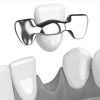Exposed Nerves
An exposed nerve or tooth root can be caused by several conditions such as cracked or chipped teeth, cavities, trauma or overly aggressive brushing. The most common cause of what can be a very painful Springfield emergency dental situation is gum recession from periodontal disease.
How Can an Exposed Nerve Be Fixed? 
The most frequently used method by your Springfield dentist to repair an exposed nerve is a gum graft. This surgical procedure covers the injured area with of a graft of other oral tissue.
Here are the most frequently used types of gum grafting:
- Free gingival graft – This method is used to thicken the gum tissue. A thin layer of tissues is taken from the palate and placed on the area where there is gum recession. Both locations heal very quickly with no permanent damage.
- Subenithelial connective tissue graft – This procedure is used to cover exposed tooth roots. Tissue is removed from the outer layer of the palate and placed on the location where the gum is recessed.
- Acellular dermal matrix allograft – This method uses tissue that has been medically processed and donated specifically for a graft. The greatest benefit of this procedure is no tissue needs to be removed from the palate, so it is less painful.
Why is Gum Grafting Used for an Exposed Nerve?
Here are the advantages of gum grafting:
- Reduced sensitivity – Eating or drinking hot or cold foods can create a large amount of pain when the tooth’s root is exposed. Grafting permanently covers this area, eliminates pain and restores the good health of the gums.
- Improved appearance – Periodontal disease can make the teeth look “long” as the gum recedes. Grafting improves how the gums look with permanently taking care of the issue.
- Better gum health – Periodontal disease can progressively destroy the bone. Grafting can aid in stopping this disease and prevents future problems an exposed tooth root provides.



